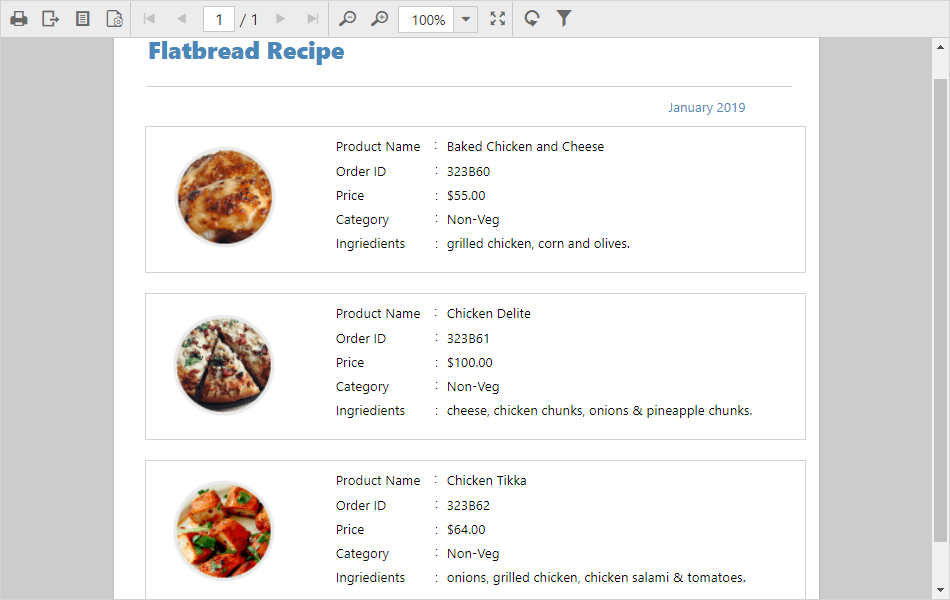Render RDLC report
20 Feb 201910 minutes to read
The data binding support, allows you to view RDLC reports that exist on the local file system with JSON array and custom business object data collection. The following steps demonstrates how to render a RDLC report with JSON array and custom business object data collection.
NOTE
Add the RDLC report
Product List.rdlcfrom Syncfusion installation location to your applicationApp_Datafolder. For more information, see Samples and demos.
Bind data source at client side
1.Set the RDLC report path to the reportPath property.
2.Assign the processingMode property to ProcessingMode.Local.
3.Bind the JSON array collection to the dataSources property as shown in following code.
<div style="height: 100%; width: 100%;">
<div style="height: 600px; width: 950px; min-height: 400px;" id="viewer"></div>
<script type="text/javascript">
$(function () {
$("#viewer").ejReportViewer({
reportServiceUrl: "/api/ReportsApi",
processingMode: ej.ReportViewer.ProcessingMode.Local,
reportPath: '~/App_Data/Product List.rdlc',
dataSources: [{
value: [
{
ProductName: "Baked Chicken and Cheese", OrderId: "323B60", Price: 55, Category: "Non-Veg", Ingredients: "Grilled chicken, Corn and Olives.", ProductImage: ""
},
{
ProductName: "Chicken Delite", OrderId: "323B61", Price: 100, Category: "Non-Veg", Ingredients: "Cheese, Chicken chunks, Onions & Pineapple chunks.", ProductImage: ""
},
{
ProductName: "Chicken Tikka", OrderId: "323B62", Price: 64, Category: "Non-Veg", Ingredients: "Onions, Grilled chicken, Chicken salami & Tomatoes.", ProductImage: ""
}],
name: "list"
}]
});
});
</script>
</div>4.Build and run the application to view the output result.
Bind data source in Web API controller
The following steps help you to configure the Web API to render the RDLC report with business object data collection.
1.Create a class and methods that returns business object data collection. Use the following code in your application Web API Service.
public class ProductList
{
public string ProductName { get; set; }
public string OrderId { get; set; }
public double Price { get; set; }
public string Category { get; set; }
public string Ingredients { get; set; }
public string ProductImage { get; set; }
public static IList GetData()
{
List<ProductList> datas = new List<ProductList>();
ProductList data = null;
data = new ProductList()
{
ProductName = "Baked Chicken and Cheese",
OrderId = "323B60",
Price = 55,
Category = "Non-Veg",
Ingredients = "grilled chicken, corn and olives.",
ProductImage = ""
};
datas.Add(data);
data = new ProductList()
{
ProductName = "Chicken Delite",
OrderId = "323B61",
Price = 100,
Category = "Non-Veg",
Ingredients = "cheese, chicken chunks, onions & pineapple chunks.",
ProductImage = ""
};
datas.Add(data);
data = new ProductList()
{
ProductName = "Chicken Tikka",
OrderId = "323B62",
Price = 64,
Category = "Non-Veg",
Ingredients = "onions, grilled chicken, chicken salami & tomatoes.",
ProductImage = ""
};
datas.Add(data);
return datas;
}
}2.Set the ProcessingMode to ProcessingMode.Local and ReportPath to the RDLC report location.
3.Bind the business object data values collection by adding new item to the DataSources as in the following code snippet.
public void OnInitReportOptions(ReportViewerOptions reportOption)
{
reportOption.ReportModel.ProcessingMode = ProcessingMode.Local;
reportOption.ReportModel.ReportPath = System.Web.Hosting.HostingEnvironment.MapPath(@"~/App_Data/Product List.rdlc");
reportOption.ReportModel.DataSources.Add(new Syncfusion.Reports.EJ.ReportDataSource { Name = "list", Value = ProductList.GetData() });
}NOTE
Here the
Nameis case sensitive and it should be same as in the data source name in the report definition.
TIPS
The
Valueaccepts IList, DataSet, and DataTable inputs.
4.Build and run the application, the result shown as in the following screenshot.

Load report as stream
To load report as a stream, create a report stream using the FileStream class and assign the report stream to the Stream property.
public void OnInitReportOptions(ReportViewerOptions reportOption)
{
string filePath = System.Web.Hosting.HostingEnvironment.MapPath(@"~/App_Data/Product List.rdlc"); ;
// Opens the report from application App_Data folder using FileStream
FileStream reportStream = new FileStream(filePath, FileMode.Open, FileAccess.Read);
reportOption.ReportModel.Stream = reportStream;
reportOption.ReportModel.DataSources.Add(new Syncfusion.Reports.EJ.ReportDataSource { Name = "list", Value = ProductList.GetData() });
}NOTE
In the above code,
Product List.rdlcreport is loaded from theApp_Datafolder location.